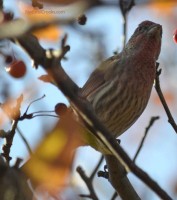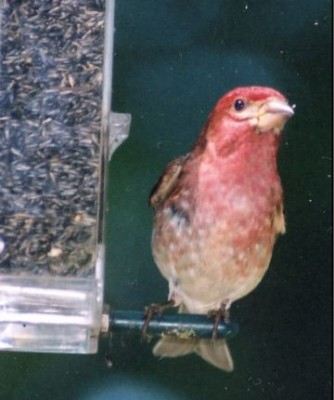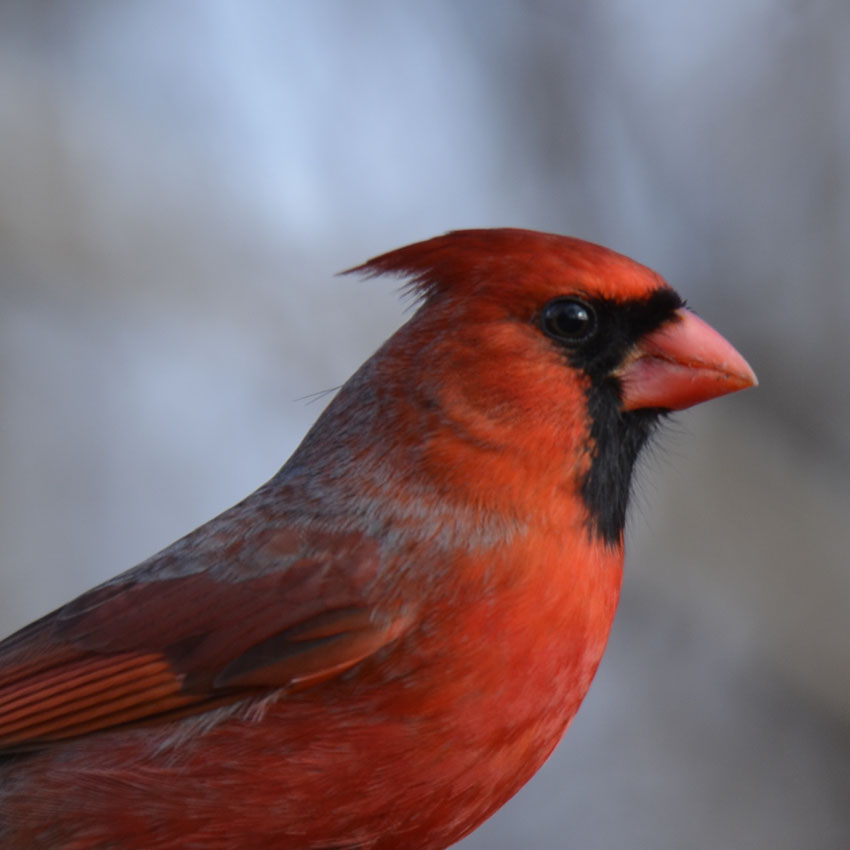There are four birds about the size of a sparrow that visit feeders in Ontario that are splashed with varying amounts of rosy pink and red. Some of them are common in Toronto and Kingston in the winter. Others are more rare.
The common winter feeder visitors with a rosy tint are male Common Redpolls and male House Finches. In fact, House Finches are common on Ontario feeders year round.
Common Redpolls Enjoy Nyjer Seeds at Ontario Feeders in Winter
Common Redpolls tend to nest very far north in Canada. Some years they come south to Toronto, London, Kingston and other communities in the winter. They have always been a winter visitor. I can remember my Great Aunt’s pleasure in reporting their return to her Toronto feeders in the early winter back in the 1970s.
 Male Common Redpolls have a noticeably bright yellow bill and a sharply defined button of very dark red on the top of their heads. They usually have a pink blush of colour on their chest.
Male Common Redpolls have a noticeably bright yellow bill and a sharply defined button of very dark red on the top of their heads. They usually have a pink blush of colour on their chest.
The word “poll” means a part of the top of the head. So the name red poll is a hint about the red colour on the top of the head.
Redpolls like to feed on birch seeds. At feeders they enjoy nyjer seeds.
House Finches Need Feeder Seeds to Survive Winter
 House Finches, on the other hand, first arrived in Ontario in the 1970s. A western bird accidentally introduced into the wild in the eastern United States, House Finches have settled in and spread out. They don’t actually handle cold very well. Southern Ontario is the northern-most part of their range.
House Finches, on the other hand, first arrived in Ontario in the 1970s. A western bird accidentally introduced into the wild in the eastern United States, House Finches have settled in and spread out. They don’t actually handle cold very well. Southern Ontario is the northern-most part of their range.
Unlike male Cardinals, male House Finches do not all look almost alike. Some have very dark red over most of their head and throat, others have lighter red markings. In general, though, they are bright red on the face and front under the neck. The generous brown streaks are a good id feature. According to allaboutbirds.org there is a bright red rump that shows up best when they are flying. I haven’t particularly noticed it myself.
House Finches rely heavily on feeders in the winter to eat enough to keep warm. They particularly like black oil sunflower seeds.
Purple Finches Often Give Southern Ontario a Miss in Winter
 Purple finches may visit feeders, but the prediction for the winter of 2012/13 is that most of them will winter further south than Ontario.
Purple finches may visit feeders, but the prediction for the winter of 2012/13 is that most of them will winter further south than Ontario.
This photo is a Male Purple Finch in his breeding plumage. In the winter, the feathers are less bright. You can see there is a lot less streaking than on a male House Finch. Purple Finches also have some red and pink on their backs, not just on their fronts.
Hoary Redpolls Are Uncommon Feeder Visitors
Hoary Redpolls are very uncommon in southern Ontario. They are a pale imitation of a Common Redpoll. If you seriously think you have one at your feeder, check for details on a reliable site like allaboutbirds.org. If you can get clear photos, it will make it easier to decide whether you have a Hoary Redpoll munching on your nyjer or sunflower seeds. A lighter than average Common Redpoll is a much more common sighting that a Hoary Redpoll in southern Ontario.
Cardinals Brighten Up the Feeder, Too
Of course, the largest red bird visiting feeders is the male Northern Cardinal. It’s not sparrow-sized though, unless you have super-sized your sparrows!
Other Suspects
There are other small, feeder visiting red birds in western Canada. You may want to check a site like allaboutbirds.org which covers the entire continent for more info.
Further Information
An interesting report describes the seed eaters of Algonquin Park at http://www.algonquinpark.on.ca/pdf/winter_finches_intro.pdf
Join In
Have you had House Finches or Redpolls visiting your feeders? Please share your experiences with a comment.


We have encountered cardinals but we have seen some red on the breasts but considerably smaller, More the size of a sparrow. We have seen them all winter. any ideas?
I’m not sure–they would very interesting!